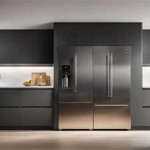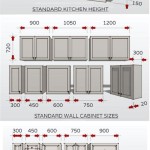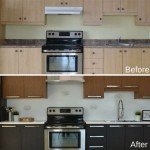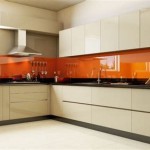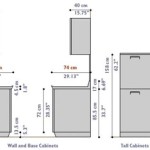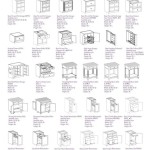How To Paint Raw Wood Kitchen Cabinets
Painting raw wood kitchen cabinets is a project that can drastically transform the appearance of a kitchen. While it might seem daunting, with the proper preparation, materials, and techniques, a professional-looking finish is achievable. This article provides a detailed guide on how to paint raw wood kitchen cabinets effectively and efficiently.
Key Point 1: Thorough Preparation is Paramount
The success of any painting project largely depends on the preparation phase. With raw wood, this is especially critical as untreated surfaces are highly absorbent and prone to issues if not properly addressed. This initial stage consumes a significant amount of time, but it directly impacts the longevity and quality of the finished product.
Begin the preparation by removing all hardware, including knobs, pulls, hinges, and any other attached components. This allows for complete and even coverage without obstructions. Store the hardware in labeled bags to ensure easy reinstallation later. If the cabinets have doors and drawers, remove them from the cabinet frames. Laying them flat for painting prevents drips and ensures uniform coating.
Next, clean the raw wood surfaces meticulously. Even if the wood appears clean, it may have accumulated dust, dirt, or manufacturing residues. Use a tack cloth or damp cloth to wipe down all surfaces. For stubborn stains or grease, a mild detergent solution can be used, followed by a clean water rinse and thorough drying. Allow the wood to dry completely before proceeding to the next step.
Sanding is a vital step in preparing raw wood for painting. It creates a slightly rough surface, which promotes better adhesion of the primer and paint. Start with a medium-grit sandpaper (around 120-grit) to smooth out any imperfections or raised grain. Then, switch to a finer-grit sandpaper (around 220-grit) for the final sanding. Sand in the direction of the wood grain to avoid creating unsightly scratches. Pay close attention to edges and corners, ensuring they are smooth and slightly rounded. After sanding, remove all sanding dust with a vacuum cleaner equipped with a brush attachment, followed by a tack cloth wipe-down.
Priming is an essential step for raw wood cabinets. Primer seals the wood, prevents paint absorption, and provides a uniform base for the paint to adhere to. Choose a high-quality oil-based or acrylic-latex primer specifically designed for wood. Oil-based primers generally offer better sealing properties and stain blocking, while acrylic-latex primers are easier to clean up and have lower VOCs. Apply the primer evenly using a brush, roller, or sprayer, following the manufacturer's instructions. Ensure all surfaces, including edges and corners, are thoroughly coated. Let the primer dry completely according to the manufacturer's recommendations. After the primer dries, lightly sand it with fine-grit sandpaper (around 320-grit) to create an even smoother surface. Remove all sanding dust before applying the paint.
Key Point 2: Selecting the Right Paint and Tools
Choosing the appropriate paint and tools is crucial for achieving a professional-looking finish on raw wood kitchen cabinets. The type of paint, brushes, rollers, and sprayer all play a significant role in the final outcome.
For kitchen cabinets, consider using a high-quality paint specifically formulated for cabinets or furniture. Acrylic-latex enamel paints are a popular choice due to their durability, ease of cleaning, and low VOC content. Oil-based enamel paints provide a harder, more durable finish, but they require more effort to clean up and have higher VOCs. Alkyd enamels are another option, offering a good balance between durability and ease of use. Choose a paint with a sheen level that suits your preferences. Semi-gloss and gloss finishes are more durable and easier to clean, making them ideal for kitchens, while satin and eggshell finishes offer a softer, less reflective look. Consider the existing décor and lighting in the kitchen when selecting the sheen level.
When selecting brushes, opt for high-quality synthetic brushes with tapered bristles. These brushes provide a smooth, even application and minimize brush strokes. For larger, flat surfaces, use a small, high-density foam roller. Foam rollers create a smooth, almost spray-like finish, minimizing texture. If you prefer using a paint sprayer, consider an airless sprayer or an HVLP (high volume, low pressure) sprayer. Sprayers provide the most even and professional-looking finish, but they require more practice and careful preparation to avoid runs and drips.
In addition to brushes, rollers, and sprayers, gather other essential tools, including paint trays, liners, painter's tape, drop cloths, putty knife, and a caulking gun. Painter's tape is used to mask off areas that you don't want to paint, such as walls, countertops, and appliance casings. Drop cloths protect your floors and other surfaces from paint splatters. A putty knife is used to fill in any holes or imperfections in the wood before priming. A caulking gun is used to apply caulk along the edges of the cabinets to create a seamless, professional look.
Key Point 3: Applying the Paint with Precision
Once the preparation is complete and the right materials are selected, the next step is to apply the paint carefully and methodically. Proper technique is essential for achieving a smooth, even, and durable finish.
Before starting, ensure the work area is well-ventilated. Open windows and doors, and use fans to circulate the air. This will help the paint dry faster and reduce the accumulation of fumes. Protect surrounding surfaces with drop cloths and painter's tape. Cover any hardware that cannot be removed, and mask off the walls and countertops adjacent to the cabinets.
Begin by applying a thin, even coat of paint to the edges and corners of the cabinets using a brush. These areas are often difficult to reach with a roller or sprayer, so it's important to pay close attention to detail. Use a technique called "tipping off" to smooth out any brush strokes. After applying the paint, lightly drag the brush across the surface in the direction of the wood grain to eliminate any visible brush marks.
For the larger, flat surfaces of the cabinets, use a foam roller or paint sprayer. If using a roller, load the roller with paint and apply it in consistent, overlapping strokes. Avoid pressing too hard, as this can create an uneven finish. If using a paint sprayer, follow the manufacturer's instructions carefully. Hold the sprayer at a consistent distance from the surface and move it in smooth, even strokes. Overlap each stroke slightly to ensure complete coverage. Avoid applying too much paint in one area, as this can lead to runs and drips.
After applying the first coat of paint, allow it to dry completely according to the manufacturer's recommendations. Drying times can vary depending on the type of paint, humidity, and temperature. Once the first coat is dry, lightly sand the surface with fine-grit sandpaper (around 320-grit) to remove any imperfections or dust particles. This will also create a slightly rough surface for the second coat of paint to adhere to. Remove all sanding dust with a vacuum cleaner and tack cloth.
Apply a second coat of paint using the same techniques as the first coat. Again, ensure even coverage and avoid runs and drips. Allow the second coat to dry completely. If necessary, apply a third coat of paint for maximum durability and coverage. After the final coat of paint is dry, carefully remove the painter's tape and drop cloths. Reinstall the hardware and reattach the doors and drawers to the cabinet frames.
Inspect the finished cabinets for any imperfections or missed spots. Touch up any areas as needed with a small brush. Allow the paint to cure completely before using the cabinets. Curing times can vary depending on the type of paint, but it typically takes several days or weeks for the paint to reach its maximum hardness and durability.
Cleaning up after the painting process is essential to maintain your tools and work area. Clean brushes and rollers immediately after use with the appropriate cleaner (water for latex paints, mineral spirits for oil-based paints). Dispose of paint cans and other waste materials properly. Store leftover paint in airtight containers in a cool, dry place.
By following these detailed steps, painting raw wood kitchen cabinets can transform the aesthetics of your kitchen into a pleasing space. Proper preparation, the selection of suitable materials, and meticulous application techniques are the key to achieving a professional and long-lasting finish. This effort contributes significantly to the overall value and enjoyment of your kitchen space.

How To Paint Unfinished Cabinets Houseful Of Handmade

How To Paint Kitchen Cabinets Without Sanding Or Priming

Unlock The Secrets Of Painting Unfinished Cabinets A Comprehensive Guide

How To Stain Unfinished Cabinets Painting By The Penny

How To Paint Kitchen Cabinets In 7 Simple Steps

How To Stain Unfinished Cabinets Painting By The Penny

How To Paint Oak Cabinets And Hide The Grain Tutorial

How To Paint Unfinished Cabinets Houseful Of Handmade

How To Paint Stained Oak Cabinet Doors Honey Built Home

How To Paint Pressed Wood Kitchen Cabinets Choice Cabinet
Related Posts

